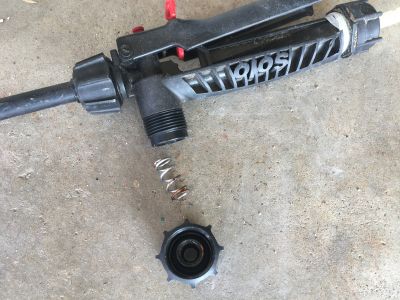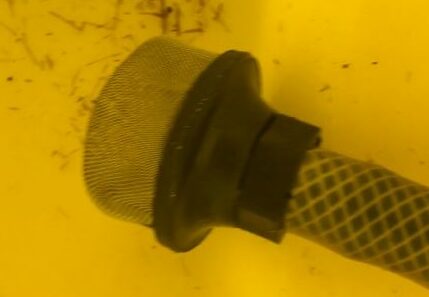Pump sprayers are simple machines. They can be used for many different applications. But whether you’re using it to spray deck stain, concrete sealer, herbicide, or insecticide, pump sprayers tend to get clogged.
It’s an annoying problem and if you are dealing with a pump sprayer that is clogged you obviously want a solution. Well, the key to avoiding clogs in a pump sprayer is to prevent foreign debris from getting into the sprayer tank and flushing out the sprayer after each use.
Keeping debris out of your sprayer is easier said than done and there are different methods to flush out your sprayer. I plan to cover both in detail in this article. So if you want help with your pump sprayer issues keep on reading for more information.
Fixing a Clogged Sprayer
A clogged sprayer is useless. The best way to avoid clogs is to take proper care of your sprayer by rinsing it often, cleaning nozzles, and using strainers when possible.
Sometimes sprayers clog even when you take these precautions. If that is the case you don’t know how to throw your sprayer away. There are things you can do to get it unplugged and working again.
Clean
When your sprayer is clogged to the point that it is not working most likely you will need to disassemble the sprayer and perform a deep clean. Sludge and grime tend to gum up any moving parts of the sprayer. This can obviously lead to clogs but it can also cause the trigger or pump assembly to fail completely.
Each sprayer is different, but generally, you can open the trigger valve carefully to remove the stem, spring, seals, and packing inside that make the trigger function. These can be cleaned with soap or detergent carefully. Stubborn grime should be gently scrubbed with a brush.
Severe buildup inside of the sprayer can be hard to remove. Hot soapy water can be used to try and flush out hoses, wands, triggers guns, nozzles, etc.
Lubricate
The moving parts of a hand pump sprayer won’t seal or move easily when gummed up with grime. This can also cause them to dry out and become “locked up”. Silicone grease can be used after the sprayer components are cleaned. This makes everything operate smoothly and should return the sprayer to nearly normal function.
If your pump sprayer still has issues after taking these steps, then be sure to refer to this article about troubleshooting a hand pump sprayer.
Why Pump Sprayers Clog
Understanding what’s causing the clog in your sprayer is essential to addressing the problem. There are several factors that can lead to clogging but there are two particular things that are the root of most clogs: foreign debris and residue buildup from the liquids being sprayed. Let’s examine the specifics.
Debris and Sediment
Regardless of the liquid that you put into your sprayer, you must open the lid to fill up the tank. When you do this small debris, dust, grass clippings, or other plant matter can also make their way inside.
Chemical Residue
Chemical residue is a common result of using your sprayer to apply different herbicides and pesticide products, then not flushing the sprayer thoroughly to remove the lingering chemical. Over time, chemical residue builds up inside of a sprayer hose and wand. Some chemicals are more prone to this, resulting in a very sticky and hard-to-remove sludge. This is why it is so important to flush out the pump with fresh water or a tank cleaning agent after each use.

Chemical Makeup
Certain products may contain ingredients that are prone to causing clogs. Some products have components that can solidify or become sticky when exposed to air, moisture, or temperature changes. This can lead to blockages in the sprayer’s components.
For Example, Oil-based deck stains or thick sealers might congeal over time and clog the nozzle, preventing proper application.
Nozzle Wear/Damage
Over time, the nozzle of a hand pump sprayer can wear out or become damaged and misshaped. The broken, pinched, or warped nozzle might be more prone to clogging.
A worn-out nozzle might produce an uneven pattern that makes it seem like it is partially clogged even though it is not. For example, bleach can deteriorate nylon components and valves, causing clogs in the pump or nozzle.
Chemical Reactions
Some Chemicals can react with the plastic or rubber parts of the sprayer. This may cause them to degrade or become sticky.
Most hand pump sprayers are made with materials that have strong chemical compatibility however this does not mean that they are compatible with every product on the market. Specifically, certain types of sprayers may not be a good option for oil-based/petroleum-based products and vice versa.
Check with the manufacturer of the sprayer as well as the manufacturer of the product you’re going to spray to learn what type of rubbers and plastics are compatible. This Is important to avoid any issues.
Rust
Although most tampon sprayers are made with rubbers and plastic some have metal plunger rods. Rust that gets into the sprayer tank can Contribute to clogs. Press from outside of the sprayer can also get to the sprayer tank if you were drawing water from the tap or Spicket pipe that may have rust.
What Parts of a Pump Spray Clog?
A clog can occur in any part of a pump sprayer but they occur most often in the nozzle and the handle of the spray wand.
A spray wand trigger works as a valve. Liquid passes through a small area when the trigger is pulled. When you let go of the trigger it seals up, stopping the flow of liquid. The small stem, o-rings, seals, and other components that make the trigger work are susceptible to residue buildup, resulting in a clog or keeping the valve from opening up, limiting the amount of liquid that can pass through.

Sprayer tips are another component that can be affected by debris or residue. As this is the smallest opening In the fluid path it is the easiest spot for her for a Clog to occur.
Clogs can occur in other areas as well. The extension portion of the spray wand and the sprayer hose can be plugged. This is less common but still possible. Typically debris does not plug the hose or wand extension because there are other restrictie points (nozzle/trigger valve) that are more likely for this foreign material to get stuck. If there is clogging in a hose or wand it is typically a partial blockage that limits flow rather than a complete plug.
How to Keep a Pump Sprayer From Clogging
So how do you keep debris and chemical residue from clogging your pump sprayer? There are quite a few different things to try.
Use Strainers
Most hand pump sprayers come with spray wands that have strainers incorporated into them but not all do. If your sprayer has no filter or strainer, you can still add them. Depending on the style and brand of hand pump sprayer you have, there will be different options.
Nozzle Strainers: The nozzle is located on the end of the spray wand and it is typically removable. Many brands of spray wands have a place for a strainer to be installed inside the housing or cap that holds the nozzle in place.
The area of the spray wand that the nozzle cap connects to is known as the nozzle body. A strainer fits inside the nozzle body. There are many different styles of nozzle bodies and spray wands. This article provides a full breakdown of nozzle bodies and how to adapt different spray tips to them.
Inline strainers: Some spray wands no I have a spot for a strainer under the spray tip. If this is the case we may be able to add one somewhere else. You can purchase a small aftermarket strainer and put it in your sprayer hose. This will help to keep debris from plugging up your nozzle.
Hose End Strainers: sediment debris for material to get into your sprayer tank can be a problem. Putting a small screen on the end of your suction hose helps to remove the majority of anything that might cause a plug or clog in your spray wand or spray nozzle.

Tank Opening Screens: The best way to make sure that sand trash grass clippings or other foreign material does not put your strainer to make sure that it never gets inside the sprayer tank. Many hand-pump sprayer backpack sprayers come with a screen over the opening of the tank. It serves as a strainer keeping trash out when you add water or chemicals.
Rinse/Flush
Screens and strainers can remove large pieces of debris but for a small chemical residue that builds up over time you need to flush your sprayer to keep this from forming clogs. Simple but it can be time-consuming and takes an extra step after you finish spraying. Once you are done spraying empty the tank of any remaining chemicals into an appropriate storage container.
Then fill the sprayer tank up about a quarter full. Run the freshwater through the sprayer for a minute or two. You can also swirl the water around the inside of the tank to thoroughly rinse the inside. Empty the sprayer completely and repeat this process a couple of times.
This is known as triple rinsing and it is an effective way to remove as much chemical residue as possible. This is an extra step but it is invaluable to extend the life of your sprayer and eliminate any issues.
Tank Cleaner
There are many different types of tank cleaners. Ammonia, vinegar, and other products can be used depending on the situation and what you want to accomplish. Tank cleaners should be used when switching between two products that might not jive with one another. They also should be used when switching from a herbicide like Round Up which will kill everything, to a grass-only herbicide.
Different herbicides pesticides mixing and being diluted is a big topic that you can read more about in this article.
Clean Nozzles Periodically
In addition to flushing out the sprayer, occasionally you should take the time to clean your nozzles. Remove the spray tip and gently clean the nozzle with soapy water and a brush. Be careful to avoid damage to the nozzle. For more information check out this post on cleaning nozzles
Clogs in your pump sprayer are frustrating. By following these steps you can unclog your sprayer and prevent clogs from occuring.

